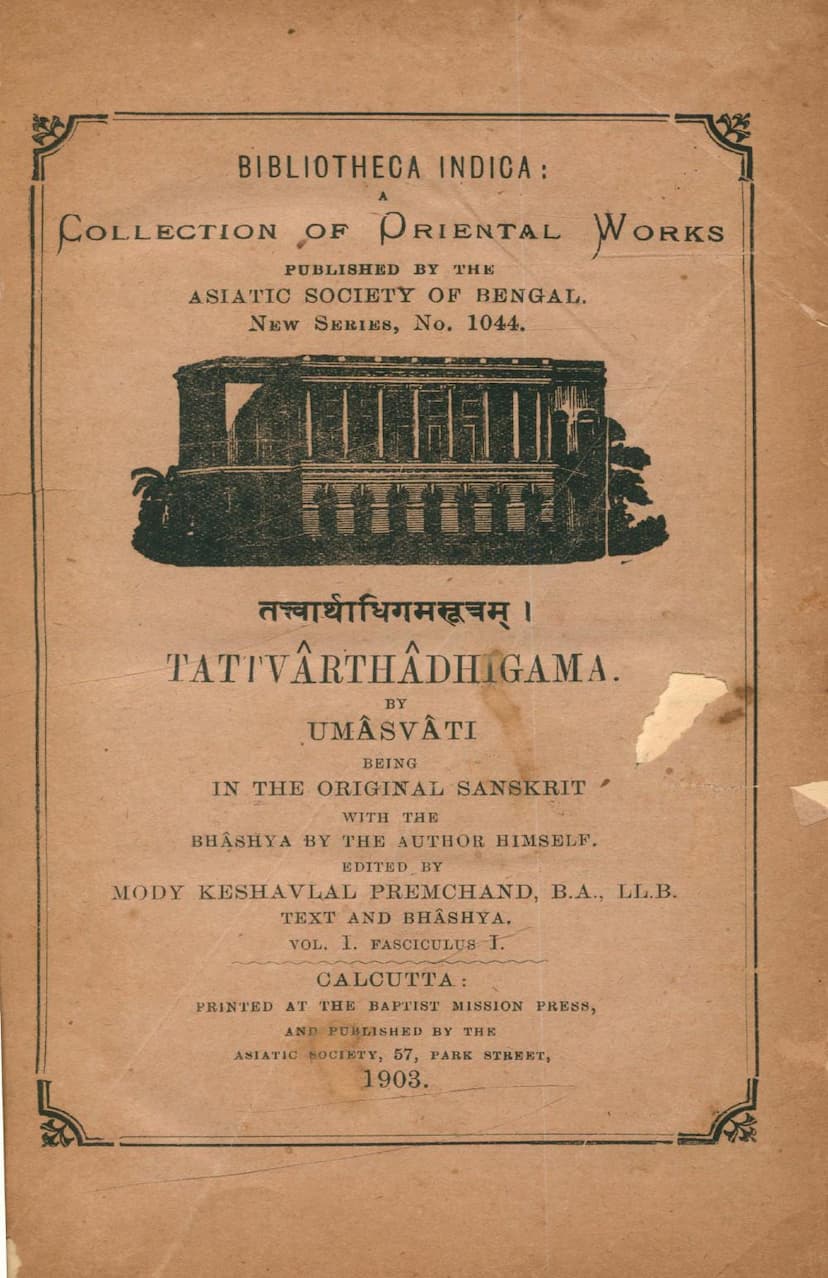Tattvarthadhigam Sutram
Added to library: September 2, 2025

Summary
Here is a comprehensive summary of the provided Jain text, "Tattvarthadhigama Sutra," based on the information from the scanned pages:
Title: Tattvarthadhigama Sutram (तत्त्वार्थाधिगमसूत्रम्)
Author: Umāsvāti (उमास्वाति)
Publisher: Asiatic Society of Bengal
Editor: Mody Keshavlal Premchand, B.A., LL.B.
Publication Year: 1903 (Vol. I, Fasciculus I), 1904 (Vol. I, Fasciculus II), 1905 (Vol. I, Fasciculus III)
Language: Sanskrit (Original Text and Commentary/Bhashya by the author)
Overview: The Tattvarthadhigama Sutra, authored by Umāsvāti, is a foundational text in Jainism. It is considered a comprehensive exposition of Jain philosophy and practice, aiming to elucidate the essence of Jain teachings, particularly the path to liberation (moksha). The text is presented in the form of sutras (aphorisms) with an extensive commentary (Bhashya) also written by Umāsvāti himself. This edition, edited by Mody Keshavlal Premchand, aims to provide an accurate and scholarly rendering of this crucial Jain work.
Key Themes and Content Covered in the Provided Sections (Chapters 1-3):
- The Path to Liberation (Moksha Marga): The text clearly defines the path to liberation as consisting of Right Faith (Samyak Darshan), Right Knowledge (Samyak Jnana), and Right Conduct (Samyak Charitra). It emphasizes that the absence of any one of these leads to the failure of achieving liberation.
- Types of Right Faith (Samyak Darshan): Right Faith is described as arising either naturally (Nisarga) or through learning and guidance (Adhigama).
- The Seven Tattvas (Realities/Categories): The core of Jain ontology is presented with the identification of the seven tattvas (realities) or substances:
- Jiva (Soul/Living Being): Defined by consciousness (chetana).
- Ajiva (Non-living Matter): Everything that is not Jiva.
- Asrava (Influx of Karma): The inflow of karmic particles due to the soul's activities.
- Bandha (Bondage): The actual binding of karma to the soul.
- Samvara (Stoppage of Influx): The prevention of new karmic influx.
- Nirjara (Shedding of Karma): The elimination of accumulated karma.
- Moksha (Liberation): The ultimate release from the cycle of birth and death. The text states these will be elaborated upon in terms of their characteristics and classification.
- The Four Types of Nykasha (Modes of Statement/Classification): The tattvas are to be understood through four modes: Nama (Name), Sthapana (Installation/Representation), Dravya (Substance), and Bhava (State/Quality).
- Knowledge (Jnana): The text categorizes knowledge into five types:
- Mati (Sense-perception based knowledge)
- Shruta (Scriptural knowledge)
- Avadhi (Clairvoyant knowledge)
- Manahparyaya (Telepathic knowledge)
- Kevala (Omniscience) It further classifies Mati and Shruta as Peroxa (indirect) knowledge, requiring external aids, while Avadhi, Manahparyaya, and Kevala are classified as Pratyaksa (direct) knowledge, being independent of external senses.
- Classification of Souls and Their States: The text discusses the soul's various states (Bhava), including Oupashamika (due to subsidence of karma), Kshāyika (due to annihilation of karma), Kshayopashamika (due to partial annihilation and subsidence), Audayika (due to maturation of karma), and Parināmika (inherent nature of the soul).
- The Six Dravyas (Substances): The text begins to elaborate on the six substances (Jiva, Ajiva, Dharma, Adharma, Akasha, Pudgala), describing their eternal nature, omnipresence (for some), formlessness (for some), and the unique characteristics of Pudgala (matter) which are formful and possess qualities like touch, taste, smell, and color.
- The Universe (Loka): The structure of the universe is described, including the concept of its threefold division (lower, middle, and upper realms) and the spatial arrangement of substances within it. The geographical divisions of the Jain universe, such as Jambudvipa, the continents (dvipa), oceans (samudra), and the central world-mountain Meru, are detailed with their dimensions and features.
- The Hellish Realms (Naraka): The seven hellish realms (Ratnaprabha, Sharkara-prabha, etc.) are described, with their increasingly hellish environments, temperatures, punishments, and the lifespans of the beings residing there.
- The Heavenly Realms (Deva): The text begins to classify the celestial beings into four categories: Bhavanavasin (dwelling in celestial palaces), Vyantara (interstitial beings), Jyotishka (luminaries), and Vaimānika (celestial beings residing in pure celestial abodes). Their lifespans and characteristics are also touched upon.
Editorial Approach: The editor, Mody Keshavlal Premchand, utilized several manuscripts in preparing this edition, as detailed in the preface. These included manuscripts from various collections and individuals, with Manuscript D (Government of Bombay collection) being described as the most correct and best. The editor also gratefully acknowledges the assistance of Maharaja Anandasagarji, his brother Dahyabhai Premchand, and particularly Professor Hermann Jacobi for his guidance and supervision. The text also includes a request for scholars to report any errors found in the publication.
Significance: The Tattvarthadhigama Sutra is highly regarded in Jainism for its systematic and logical presentation of complex philosophical concepts. It serves as a fundamental text for both the Svetambara and Digambara traditions, although variations in interpretation and textual details may exist. Its comprehensive nature makes it an essential guide for understanding the path to spiritual liberation in Jainism.